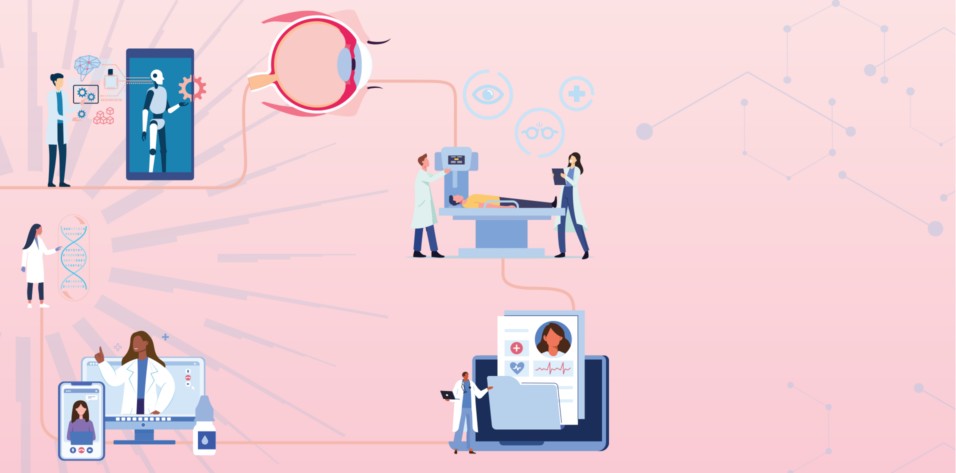
Telemedicine is poised to transform the field of ophthalmology for three main reasons. First, it allows eye care professionals to reach patients in their homes, their communities, and remote areas. Second, it improves efficiency and streamlines health care delivery systems. Third, it increases patient access to specialized care. This article provides an overview of the benefits, challenges, and potential of teleophthalmology in all three domains.
TELEOPHTHALMOLOGY MODELS
Telemedicine is a formal, structured clinical encounter conducted remotely between two or more parties. It provides diagnostic or treatment information to either the patient or a consulting physician.
Historically, telemedicine use was rare in ophthalmology. Most cases were confined to disease screening through teleretinal imaging programs. Technological advances—particularly in video conferencing, digital imaging, electronic health records, and remote monitoring—combined with pressure to see patients remotely during the COVID-19 pandemic led to remarkable growth in teleophthalmology. Clinicians can now perform live virtual consultations to diagnose eye conditions and monitor disease progression remotely. This is starting to revolutionize the way eye care is delivered.
Ophthalmic telemedicine models of care can be classified as synchronous or asynchronous and can consist of either doctor-patient interactions or doctor-doctor consultations.
Synchronous interactions. In an era dominated by virtual Zoom meetings, synchronous video-based interactions are what most people imagine when considering telemedicine. These interactions can consist of either audiovisual teleconference encounters or telephone calls with patients or consulting providers. Synchronous visits can be convenient and accessible for patients and providers, but these live interactions can be limited in what clinical information can be obtained.
Asynchronous interactions. In asynchronous telemedical care, physicians review available clinical information, ophthalmic testing (eg, visual fields, OCT, and fundus photographs), or even patient photographs before making a clinical recommendation to a physician or patient.
Hybrid telemedicine. It is also possible to mix and match models of care. In hybrid telemedicine, a patient attends an ophthalmic imaging appointment in person, the physician asynchronously reviews the images or testing, and then the physician and patient participate in a synchronous telemedical visit.
POTENTIAL BENEFITS
Health care access. Telemedicine can make eye care available to patients in their homes as well as in remote and rural areas, eliminating geographic barriers and ensuring that individuals receive timely, convenient services. Urgent triage programs using virtual video-based screening by ophthalmologists can facilitate the timely treatment of minor ophthalmic conditions and determine if and when patients should be referred for in-person evaluation. Lastly, telemedicine can also help patients get referred to appropriate subspecialists faster than traditional in-person care models.
Efficiency. By leveraging telemedicine platforms, ophthalmologists can optimize their schedules, reduce patient wait times, and manage their patient panels more efficiently. On the patient side, long travel times and associated costs can be avoided, making eye care more accessible and cost-effective.
Collaborative care. Novel FDA-approved fundus cameras enhanced with AI-based diagnostic algorithms can be placed in primary care offices and community health centers to detect eye diseases such as diabetic retinopathy in at-risk populations. Future AI models will focus on a variety of conditions, including glaucoma and age-related macular degeneration. Innovative collaborations to make ophthalmic imaging available at local pharmacies and other locations within communities could provide more accessible disease screening and open additional opportunities for virtual consultations between patients and physicians. In return, it could allow ophthalmologists to identify changes in eye health more promptly, facilitate early intervention, and potentially prevent irreversible vision loss.
Telemedicine can also enable collaboration between multiple members of an eye care team, leading to more comprehensive and coordinated patient care. Optometrists can use telemedicine to provide collaborative care for medical and surgical patients. Additionally, ophthalmologists can consult with remote specialists, share patient information, and seek second opinions.
Ophthalmic education. Residents and fellows can benefit from telemedical care by participating in virtual visits alongside experienced ophthalmologists. Young surgeons can gain insight into the diagnostic decision-making process, treatment planning, and patient management from experts (see Educational Opportunities Through Telemedicine). Additionally, this allows trainees to learn to conduct effective telemedical visits with patients.
Educational Opportunities Through Telemedicine
Sharing of Patients’ Clinical Information and Images
This enables residents, fellows, and attendings to seek second opinions from renowned experts. Expert ophthalmologists can remotely guide residents and fellows at any academic institution during patient encounters and surgical procedures.
Receiving Expert Guidance
Physicians in remote or underserved communities can use ophthalmic telemedicine to receive expert guidance, irrespective of geographic boundaries. With Cybersight from Orbis International, for example, eye doctors connect with experts, seek advice on complex cases, discuss treatment plans, and enhance their clinical decision-making skills. This collaborative model of care can help address ophthalmic shortages in remote areas.
It is important to note that hands-on training and in-person experiences remain essential for comprehensive ophthalmology education. Telemedicine is a complement to—not a substitute for—traditional training methods.
CHALLENGES
Technological barriers. The successful implementation of telemedicine requires stable internet connections, secure data transmission, and user-friendly platforms. This can be challenging to achieve in areas with limited infrastructure.
Diagnostic limitations. Certain complex procedures and detailed examinations require in-person evaluation. An inability to perform hands-on assessments and a requirement to rely solely on remote examinations limits the accuracy and scope of a diagnosis. Technological advances will hopefully continue to overcome these challenges over time.
Legal and regulatory requirements. Ophthalmologists must adhere to local laws, regulations, and privacy standards relating to telemedical care. Licensing requirements, reimbursement policies, and liability concerns vary across different jurisdictions, which can affect the implementation and expansion of telemedicine services.
CONCLUSION
Telemedicine is evolving to meet the needs of ophthalmologists and patients. Improvements in the accuracy of remote diagnostics and image analysis could expand the range of conditions that can be managed effectively with teleophthalmology. Additionally, the integration of AI and machine learning algorithms, for example, is allowing automated screening and detection of eye diseases, which could augment telemedical care and improve patient outcomes (to learn more about this subject, read the article, “AI for the Early Detection of Pathology”).
As telemedicine gains wider acceptance and reimbursement policies evolve, teleophthalmology will likely become an integral part of routine eye care. Collaborative efforts between ophthalmologists, health care institutions, and technology developers are crucial to realizing the potential of telemedicine.


